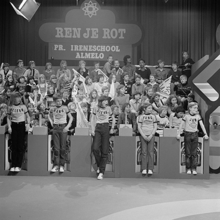Runaround (game show)
| Runaround | |
|---|---|
| Created by | Heatter-Quigley Productions |
| Presented by | Paul Winchell |
| Narrated by | Kenny Williams |
| Country of origin | United States |
| No. of seasons | 1 |
| No. of episodes | 13 |
| Production | |
| Running time | 30 Minutes |
| Release | |
| Original network | NBC |
| Picture format | NTSC |
| Original release | September 9, 1972 – September 1, 1973 |
Runaround was a children's television game show produced by Heatter-Quigley Productions. The program was hosted by ventriloquist and voice actor Paul Winchell, airing Saturday mornings on NBC from September 9, 1972 to September 1, 1973. Paul would frequently use his dummies, Jerry Mahoney and/or Knucklehead Smiff on his program. The program was announced by Kenny Williams (as most Heatter-Quigley shows were), with music by Mort Garson. However, the show received low ratings and was canceled following the first season.
Format
The basic format of the game invited nine children to answer a three-way multiple choice question by running towards their chosen answer, then standing on marked areas numbered 1, 2 or 3. Just before the correct answer is revealed, the host invites the children to "Runaround... now!" at which point they have a split second to jump onto a different area; the premise is to give opponents the "runaround" in case they are merely following their movements.
Host Winchell would say, before giving the correct answer, "When you hear the click, stick!" and then a moment later, "Last chance!", after which point he would press a finger-clicker (a toy device that made a clicking sound). Players still moving or not on one of the three answer areas were eliminated from the round (sent to a penalty area at the side of the stage). Winchell would then say, "Let's see who's right with the light!", whereupon the house lights would dim and the area for the correct answer would light up. Players with the correct answer took a pink ball from a large bowl near the middle of the stage; players with the incorrect answer were eliminated from the round. Each player had a transparent tube, into which the balls were dropped (this was a substitute scoring device for toteboards, which the show did not have). The player with the most balls at the end of the show was the day's winner.
International versions
British version
Dutch version (Ren je Rot/Kies je Ster)

| Wikimedia Commons has media related to Ren je rot. |
- The format was sold to the Netherlands for broadcast on TROS. Ren je Rot (the Dutch translates as Run Till You Drop) began on October 5, 1973 and was presented by actor Martin Brozius (and sideman Lars Boom). His catchphrase was "Rrrren je rrrot". The show kickstarted the career of magician Hans Kazan who first expressed his skills during the 1976/77 season.
- The 123rd and final Ren je Rot was broadcast on June 1, 1983; TROS felt that it was time for new programmes. Martin Brozius continued performing at parties and events, but in the late 1980s/early 1990s his career was dented by tax- and health problems that he never fully recovered from.
- Kazan filled the Ren je Rot-shaped void with his Blufshow before commercial station RTL asked him to present The Price is Right. Touring relentlessly with his Magic Show (which included his two sons and daughter-in-law) he moved to Spain in the late 1990s to get his own share of bankruptcy.
- In 2002 both Martin Brozius and Hans Kazan appeared on I Love 1978 to look back on Ren je Rot. The former learned from his daughter stealing the questionnaire, the latter was quoted "If (Ren je Rot) was shown today it would've been a hit again".
- Kazan wasn't far from the truth, as the programme is now resurrected as Kies je Ster (Pick your Star, basically the Dutch version of Poparound). It is hosted by the members of three-piece girl group Djumbo for joint broadcast on TROS and Sterren.nl, a satellite-channel devoted to 50 years of mainstream Dutch music.
- Suffering from diabetes Martin Brozius did not live to see Kies je Ster; like his UK-counterpart Mike Reid he died at the age of 67 on March 24, 2009.
German version (Eins, Zwei oder Drei)
- Eins, Zwei oder Drei ("One, Two or Three") began on December 10, 1977 and was the very first show on German TV to be licensed from the United States. In the show, which is produced by the public TV stations of Germany (ZDF), Austria (ORF) and until 2006, Switzerland (SF), three teams are competing; one from Germany, one from Austria and one from another country (e.g. Georgia, Bulgaria, Namibia), replacing Switzerland, which sent a team until 2006. Each of the teams consists of three children, both boys and girls, being about nine to eleven years in age. Michael Schanze hosted the first eight seasons, until 1985, when he was replaced by Birgit Lechtermann. She hosted the show for ten years. The third presenter from 1995 on was Gregor Steinbrenner, who also presented the 25th anniversary of the show in 2002, which was celebrated by staging a 25-hour quiz marathon. Daniel Fischer, who debuted in 2005, was the fourth presenter. The fifth and current presenter is the comedian Elton, who debuted in 2010.